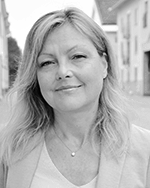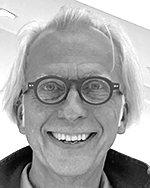
BY2030 - AN ARENA FOR LIVING ”THE FUTURE LIFE IS IN THE VILLAGE” - HOW TO BRING THE PERSPECTIVE INTO NEW EUROPEAN BAUHAUS
A hegemony or dominance prevails with respect to initiatives, priorities and discussions in society. Pretty much everything is focused on living in urban environments. The conditions of the metropolitan area characterize a large part of the development of society. Increased opportunities during the corona pandemic to work from home have contributed to people seeing the opportunity to live closer to nature. The habitats and neighborhoods outside the big city have qualities of life that attract more and more people.
Village Fair 2030 is one of the initiatives that will create opportunities to live and work outside our cities. This applies not only in Sweden but also in the rest of Europe. The question is how these habitats become beautiful, inclusive and sustainable – The key phrases within the New European Bauhaus (NEB) initiative.
Tomas Nord process manager at Smart Housing Småland guided the participants through this extremely interesting seminar with perspectives on future housing and living environment – where the interest to live “regional policy sensitive parts” was discussed. The regional and local perspective hits the bulls eye of the New European Bauhaus (NEB). The “design phase” NEB occurred during spring and summer of 2021. During that phase, a “bottom-up perspective” was seen as the most possible path for creative ideas that could shape the initiative.
The pandemic accelerates
Rural areas around Europe and Sweden are normally associated with negative concepts such as “relocation”, “strained welfare supply” and “business closures”. The question is whether that is true? In fact, a new trend is on the way in the wake of technological development and the pandemic. The holistic perspective weighs in for more and more people to choose housing a distance away from the city. Could that option also be beautiful, sustainable and inclusive?
 Christel Gustafsson, Regional Development Director in the Kronoberg Region, reported on how social stakeholders have directed the focus of on how we should live and work to the urban environment. Urbanization has become a self-fulfilling prophecy where other possibilities have not been explored or considered. Nowadays, we can see a counter urbanization where people move from urban to rural environments. We must take an interest in the appearance of a sustainable society outside the big cities.
Christel Gustafsson, Regional Development Director in the Kronoberg Region, reported on how social stakeholders have directed the focus of on how we should live and work to the urban environment. Urbanization has become a self-fulfilling prophecy where other possibilities have not been explored or considered. Nowadays, we can see a counter urbanization where people move from urban to rural environments. We must take an interest in the appearance of a sustainable society outside the big cities.
Challenge existing structures
The location of areas of responsibility is symbolic. Activities linked to state investments in Sustainable Cities fall under the National Board of Housing, Building and Planning. The policy for sustainable rural development is formulated by the Swedish Agency for Economic and Regional Growth. This is one of many examples on different approaches in different parts of the society. Banks and their way of handling house loans and mortgages also reflects this. Investments in rural projects are usually seen as “risks”. The opportunity to live and work sustainably outside larger cities will have its arena in the planned “Village Fair 2030”.
– The pandemic has not only shown us the opportunity to work from home, but also that the urban environment does not cover all our needs. When highlighting the possibilities of the countryside in a sustainable development of society, we must dare to challenge existing structures, says Christel Gustafsson.
New sustainable lifestyle
 Gunilla Kronvall is an architect working with a project called Aringsås at Engaholms Skog AB. It is a 600 hectar area between Växjö and Alvesta which is characterized by a forest, a lake and other great opportunities for recreation. The new residential areas that are planned will be designed around living close to nature. The unique character of the place should set the framework for a collaboration between all stakeholders, not least the residents. Aringsås will have a mixture of housing types based on wood. Every generation will find its place and a sustainable lifestyle is in focus “between the cities”. Nature will be a shared outdoor environment and garden.
Gunilla Kronvall is an architect working with a project called Aringsås at Engaholms Skog AB. It is a 600 hectar area between Växjö and Alvesta which is characterized by a forest, a lake and other great opportunities for recreation. The new residential areas that are planned will be designed around living close to nature. The unique character of the place should set the framework for a collaboration between all stakeholders, not least the residents. Aringsås will have a mixture of housing types based on wood. Every generation will find its place and a sustainable lifestyle is in focus “between the cities”. Nature will be a shared outdoor environment and garden.
– The Aringsås project is based on the idea that we in the future can literally “live in the middle of nature”. It is a response to housing dreams and rests on the idea of a sustainable lifestyle, says Gunilla Kronvall.
City and country in harmony
 Henrik Wibroe is the Town architect in Växjö and explained how the city has transformed from a trading center in the 14th century to the European node for sustainable construction in modern wooden building technology. With a consistent approach and attitude from the municipality – all actors – not least clients and construction contractors have gained experience of wood construction technology for all types of construction. Urban development based on wood, Henrik says, is already valued according to – even if it must be constantly developed – the words beautiful, inclusive and sustainable.
Henrik Wibroe is the Town architect in Växjö and explained how the city has transformed from a trading center in the 14th century to the European node for sustainable construction in modern wooden building technology. With a consistent approach and attitude from the municipality – all actors – not least clients and construction contractors have gained experience of wood construction technology for all types of construction. Urban development based on wood, Henrik says, is already valued according to – even if it must be constantly developed – the words beautiful, inclusive and sustainable.
Växjö will highlight the possibility of living outside urban areas. In the new master plan, the municipality works with “rural nodes” where a focus is on, among other things, the residents who choose to live in locations close to nature along the entrances to Växjö. It is important that society discusses how services and welfare should benefit everyone.
– I see a strong need for collaboration between city and country. For the urban area to function, it is required that all actors work in the same direction. We are addressing these perspectives in our planning processes, says Henrik Wibroe.
There are pitfalls
In the concluding discussion, Tomas Nord raised some key arguments and the first was about collaboration. It was stated that there may be pitfalls and even a resistance. There is also a risk that the choice to live in sparsely populated areas will not be “sustainable, beautiful and inclusive”. It is important that all actors involved in the public construction sector can visualize the “increased flow” of citizens who choose a lifestyle outside of the city.
– It is about time to raise interest for areas that are outside the city, Christel Gustafsson said. Of course, the opportunity to choose such a lifestyle is not only found in the Nordic countries. It is found throughout Europe. We will try to describe the new perspectives within the framework of the initiative “Village Fair 2030”.
If you missed one or more of our seven webinars, it is possible to watch them (Swedish) here

